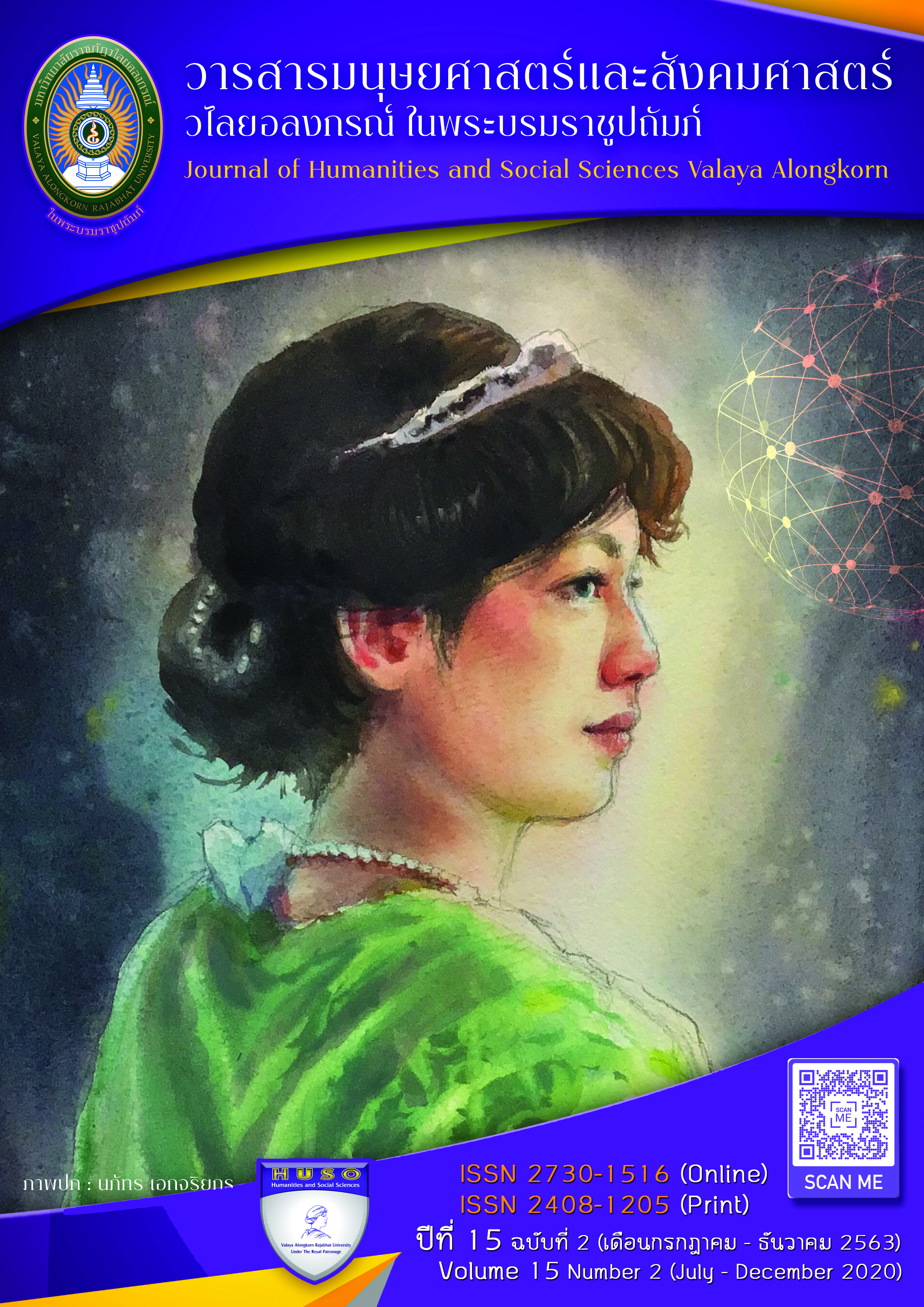THE STUDY OF EMPLOYING KIPLING’S METHOD ON THE ANALYSIS OF MARKETING MIX FACTORS THAT BEING FOCUSED BY TOURISTS WHEN TRAVELING
Main Article Content
Abstract
Knowing the marketing mix factors that tourists are focused or interested in when they decided to visit a particular tourist destination and also information on these tourists’ behavior will help ones to provide products and services that respond to the needs of those tourists correctly and appropriately, which will make tourism in that area sustain and will truly benefit all parties and all sectors in the society.
The Kipling Method (5Ws 1H) is an effective method of analysis and study of data and can be used to study tourists’ behavior and marketing mix factors that tourists focused when traveling in that tourist destinations. Here, it will be studied how to use the method of Kipling for gathering information on Tourists’ behavior and marketing mix factors that tourists focused in traveling in the destinations in details, so the findings will be useful enough for setting up the tourist destination development plan as needed later. Furthermore, a prototype of questionnaire was also provided as an example for anyone who is interested in this field to apply and adapt it easily to the relevant context.
Article Details
ลิขสิทธิ์บทความวิจัยที่ได้รับการตีพิมพ์เผยแพร่ในวารสารมนุษยศาสตร์และสังคมศาสตร์ วไลยอลงกรณ์ ในพระบรมราชูปถัมภ์ ถือเป็นกรรมสิทธิ์ของคณะมนุษยศาสตร์และสังคมศาสตร์ มหาวิทยาลัยราชภัฏวไลยอลงกรณ์ ในพระบรมราชูปถัมภ์ ห้ามนำข้อความทั้งหมดหรือบางส่วนไปพิมพ์ซ้ำ เว้นแต่จะได้รับอนุญาตจากมหาวิทยาลัยเป็นลายลักษณ์อักษร
ความรับผิดชอบ เนื้อหาต้นฉบับที่ปรากฏในวารสารมนุษยศาสตร์และสังคมศาสตร์ วไลยอลงกรณ์ ในพระบรมราชูปถัมภ์ เป็นความรับผิดชอบของผู้นิพนธ์บทความหรือผู้เขียนเอง ทั้งนี้ไม่รวมความผิดพลาดอันเกิดจากเทคนิคการพิมพ์
References
ฉลองศรี พิมลสมพงศ์. (2551). การวางแผนและพัฒนาตลาดการท่องเที่ยว. (พิมพ์ครั้งที่ 8). กรุงเทพฯ : สำนักพิมพ์มหาวิทยาลัยเกษตรศาสตร์.
นิศศา ศิลปเสริฐ. (2560). อุตสาหกรรมการท่องเที่ยว. (พิมพ์ครั้งที่ 7). กรุงเทพฯ : สำนักพิมพ์แห่งจุฬาลงกรณ์มหาวิทยาลัย.
บุญเลิศ จิตตั้งวัฒนา. (2555). พฤติกรรมนักท่องเที่ยว. นนทบุรี : เฟริ์นข้าหลวง พริ้นติ้งแอนด์พับลิชชิ่ง.
ปริณา ลาปะ. (2558, มกราคม-มิถุนายน). พฤติกรรมการท่องเที่ยวจังหวัดนครราชสีมาของนักท่องเที่ยวชาวไทย. วารสาร วิชาการบริหารธุรกิจ สมาคมสถาบันอุดมศึกษาเอกชนแห่งประเทศไทย. ปีที่4(ฉบับที่1), 42, หน้า 30-44.
รวีวรรณ โปรยรุ่งโรจน์. (2558). พฤติกรรมนักท่องเที่ยว. กรุงเทพฯ : สำนักพิมพ์โอเดียนสโตร์.
ละเอียด ศิลาน้อย. (2560). การใช้วิธีการของคิปปลิง (เทคนิคการใช้ 5Ws 1H) ในการวิเคราะห์ปัญหา. เอกสารประกอบการบรรยายวิชา 1001412 สัมมนาการท่องเที่ยวและการโรงแรม ภาคการศึกษา 1/2560 คณะการท่องเที่ยวและการโรงแรม มหาวิทยาลัยมหาสารคาม
ละเอียด ศิลาน้อย และ กันฑิมาลย์ จินดาประเสริฐ. (2561, เมษายน-มิถุนายน). การตลาดเชิงสัญชาตญาณเพื่อการเติบโตของธุรกิจอย่างยั่งยืน. วารสารสุทธิปริทัศน์, ปีที่ 32(ฉบับพิเศษ1), 241, หน้า 235-247.
เลิศพร ภาระสกุล. (2555). พฤติกรรมนักท่องเที่ยว. กรุงเทพฯ : สำนักพิมพ์แห่งจุฬาลงกรณ์มหาวิทยาลัย.
ศิริประภา205. (2560). การใช้เทคนิค 5W1H ในการวิเคราะห์ปัญหา. [ออนไลน์]. เข้าถึงได้จาก : https://sites.google.com/site/siriprapha205/5w1h. (วันที่ค้นข้อมูล : 2 มิถุนายน 2560).
สมยศ วัฒนากมลชัย. (2555). ความรู้เบื้องต้นเกี่ยวกับการท่องเที่ยวและอุตสาหกรรมท่องเที่ยว, หน่วยที่ 14. กรุงเทพฯ : สำนักพิมพ์มหาวิทยาลัยสุโขทัยธรรมาธิราช.
สุวีร์ณัสญ์ โสภณศิริ. (2554). การวิเคราะห์พฤติกรรมนักท่องเที่ยว. กรุงเทพฯ : สำนักพิมพ์อินทนิล.
สุวัฒน์ จุธากรณ์. (2555). ความรู้เบื้องต้นเกี่ยวกับการท่องเที่ยวและอุตสาหกรรมท่องเที่ยว, หน่วยที่ 2. กรุงเทพฯ : สำนักพิมพ์มหาวิทยาลัยสุโขทัยธรรมาธิราช.
สุวันชัย หวนนากลาง. (2555). ความรู้เบื้องต้นเกี่ยวกับการท่องเที่ยวและอุตสาหกรรมท่องเที่ยว, หน่วยที่ 5. กรุงเทพฯ : สำนักพิมพ์มหาวิทยาลัยสุโขทัยธรรมาธิราช.
ศิวฤทธิ์ พงศกรรังศิลป์. (2555). หลักการตลาด. กรุงเทพฯ : สำนักพิมพ์ท้อป จำกัด.
ศุภลักษณ์ อัครางกูร. (2547). พฤติกรรมนักท่องเที่ยว. ขอนแก่น : ห้างหุ้นส่วนโรงพิมพ์คลังนานาวิทยา.
Horner, Susan, and Swarbrooke, Jonn. (2016). Consumer Behavior in Tourism. (Third edition). New York : Routledge.
Inskeep, Edward. (1991). Tourism Planning : an intergrated and sustainable development approach. Canada : Van Nostrand Reinhold.
Kipling, R. (1902). Just so stories. TBCL’s Children’s Bookcase. [ออนไลน์] : http://www.boop.org/jan/justso/. (วันที่ค้นข้อมูล : 13 สิงหาคม 2560). จาก Http://sites.google.com/site/siriprapha205/5w1h
Kotler, Philip, and Armstrong, Gary. (1996). Principles of Marketing. (7th ed). New Jersey 07458. : Prentice Hall, Upper Saddle River.
Kotler, Philip T., Bowen, John T., Makens, James, and Balogu, Seyhmus. (2017). Marketing for Hospitality and Tourism. (7th ed) England : Pearson.
Mario Dubios. (2017). Kipling and 5W1H to define problems, needs and business opportunities. [ออนไลน์]. : http://substance-en.etsmtl.ca/kipling-5w1h-define-problems-needs-business-opportunities. (วันที่ค้นข้อมูล : 13 สิงหาคม 2560).
Möller, O. et al. (2014). The Kipling method. Site Web consulté le 25 février 2014. [ออนไลน์]. : http://projectofhow.com/methods/the-kipling-method/. (วันที่ค้นข้อมูล : 13 สิงหาคม 2560).จาก https://sites.google.com/site/siriprapha205/5w1h.
Swarbrooke, John, and Horner, Susan. (2003). Consumer Behavior in Tourism. Burlington : MA. Butterworth-Heinemann.


